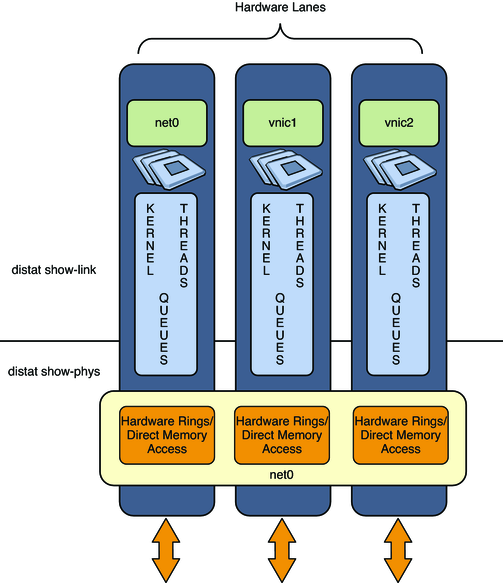| Skip Navigation Links | |
| Exit Print View | |

|
Using Virtual Networks in Oracle Solaris 11.1 Oracle Solaris 11.1 Information Library |
| Skip Navigation Links | |
| Exit Print View | |

|
Using Virtual Networks in Oracle Solaris 11.1 Oracle Solaris 11.1 Information Library |
1. Network Virtualization and Resource Management in Oracle Solaris
2. Creating and Administering Virtual Networks in Oracle Solaris
3. Managing Network Resources in Oracle Solaris
4. Monitoring Network Traffic and Resource Usage in Oracle Solaris
Commands for Monitoring Traffic Statistics
Gathering Statistics About Network Traffic on Links
Obtaining Network Traffic Statistics on Network Devices
Obtaining Network Traffic Statistics on Lanes
Obtaining Network Traffic Statistics on Link Aggregations
Gathering Statistics About Network Traffic on Flows
Configuring Network Accounting for Network Traffic
How to Set Up Network Accounting
Packets traverse a path when they flow into or out of a system. On a granular level, packets are received and transmitted through receive (Rx) rings and transmit (Tx) rings of a NIC. From these rings, received packets are passed up the network stack for further processing while outbound packets are sent to the network.
This section introduces the concept of network lanes. A network lane is a combination of system resources that are allocated to manage network traffic. Thus, network lanes are customized paths for specific types of network traffic. Each lane can be either a hardware lane or a software lane. In addition, each lane type can be either a receive lane or a transmit lane.
The distinction between hardware and software lanes is based on a NIC's ability to support rings and ring allocation as described in Working With Clients, Transmit Rings, and Receive Rings. This chapter focuses primarily on incoming traffic that is received through receive lanes.
Note - Rx and Tx rings, as well as other network resources, are assigned by setting properties of datalinks. Therefore, datalinks are the network lanes on a system.
On hardware lanes, packets have exclusive use of rings that are assigned to those lanes. In contrast, rings on software lanes are shared by all network packets on those lanes.. Datalinks are configured to share rings for the following reasons:
Administrative intent. The datalink might not be performing intensive processes to require dedicated rings.
The NIC does not support ring allocation.
Despite support for ring allocation, rings are no longer available to be assigned for exclusive use.
The following figure shows different hardware lanes.
Figure 4-1 Hardware Lanes

Figure 4-1 shows the following configuration:
Two VNICs are configured over net0: vnic1 and vnic2. As the primary client, net0 is also the primary lane. The VNICs as secondary clients are also network lanes.
Sets of hardware rings are assigned to the secondary clients. Each client, including the primary client, functions as a hardware lane.
A set of CPUs is allocated to each lane.
The subsequent sections describe how you monitor the traffic that flows through these lanes.